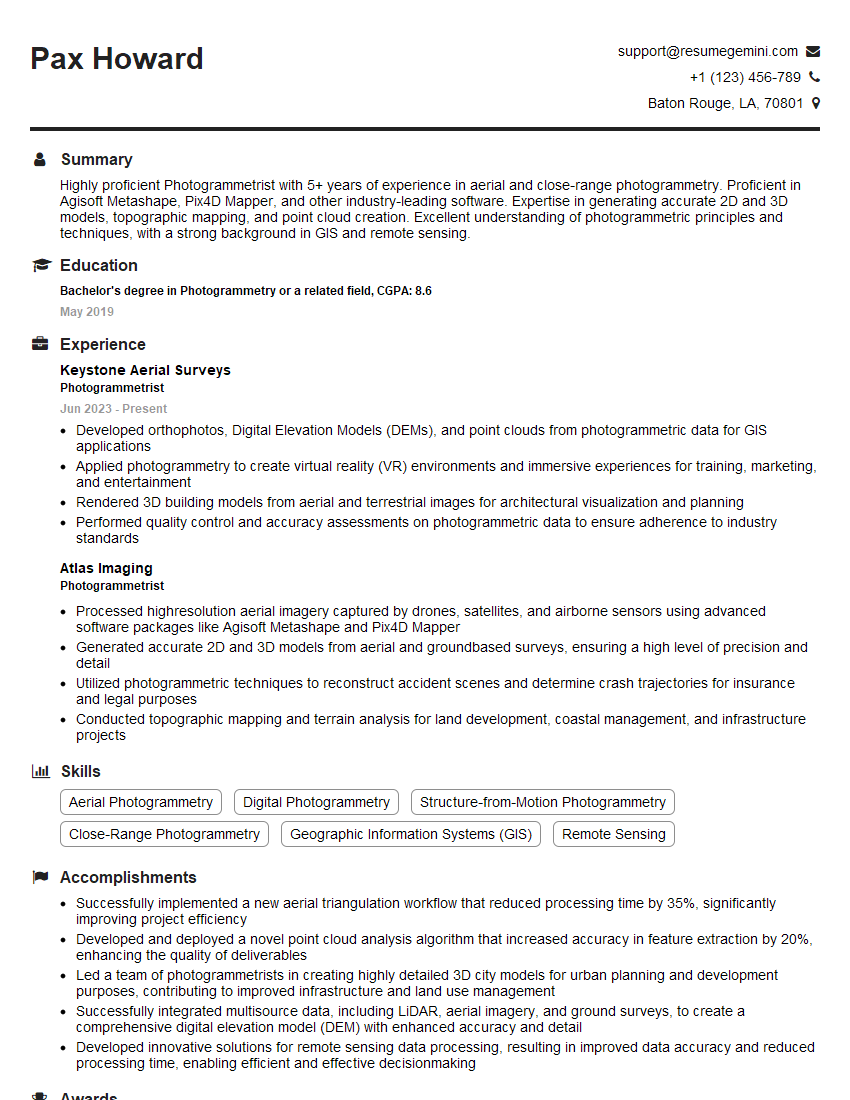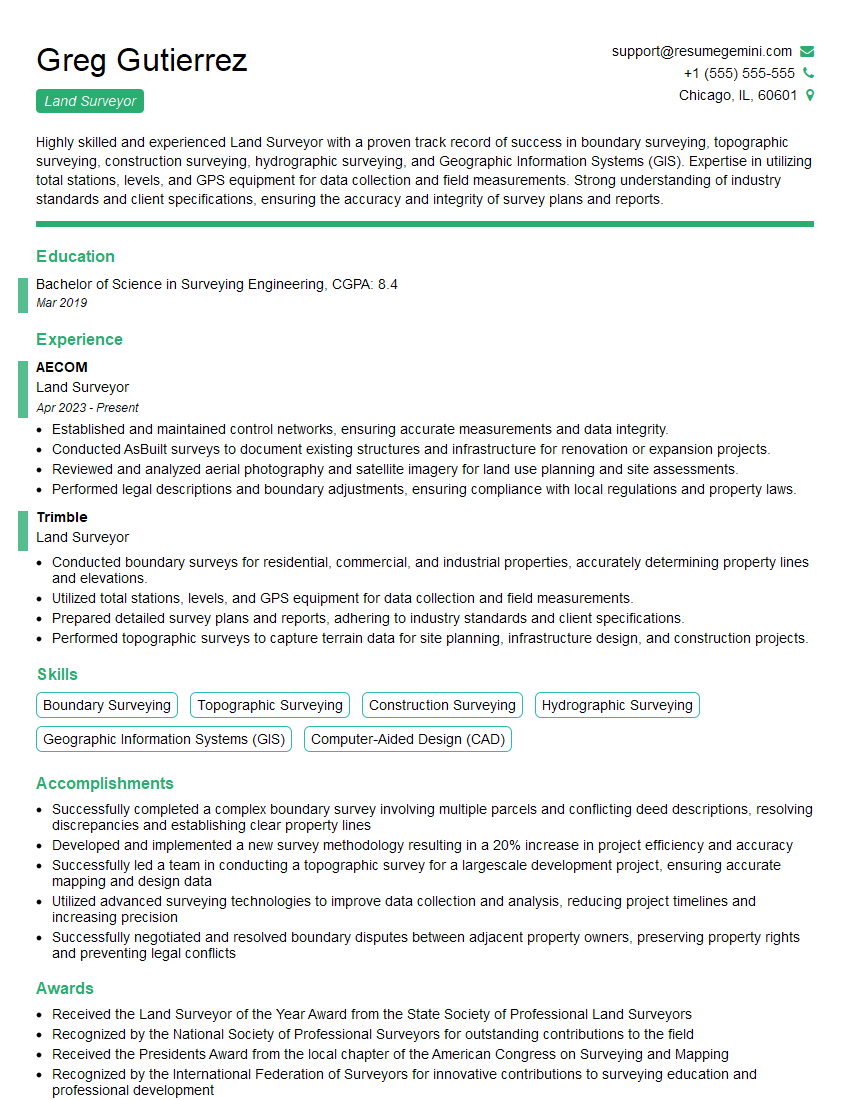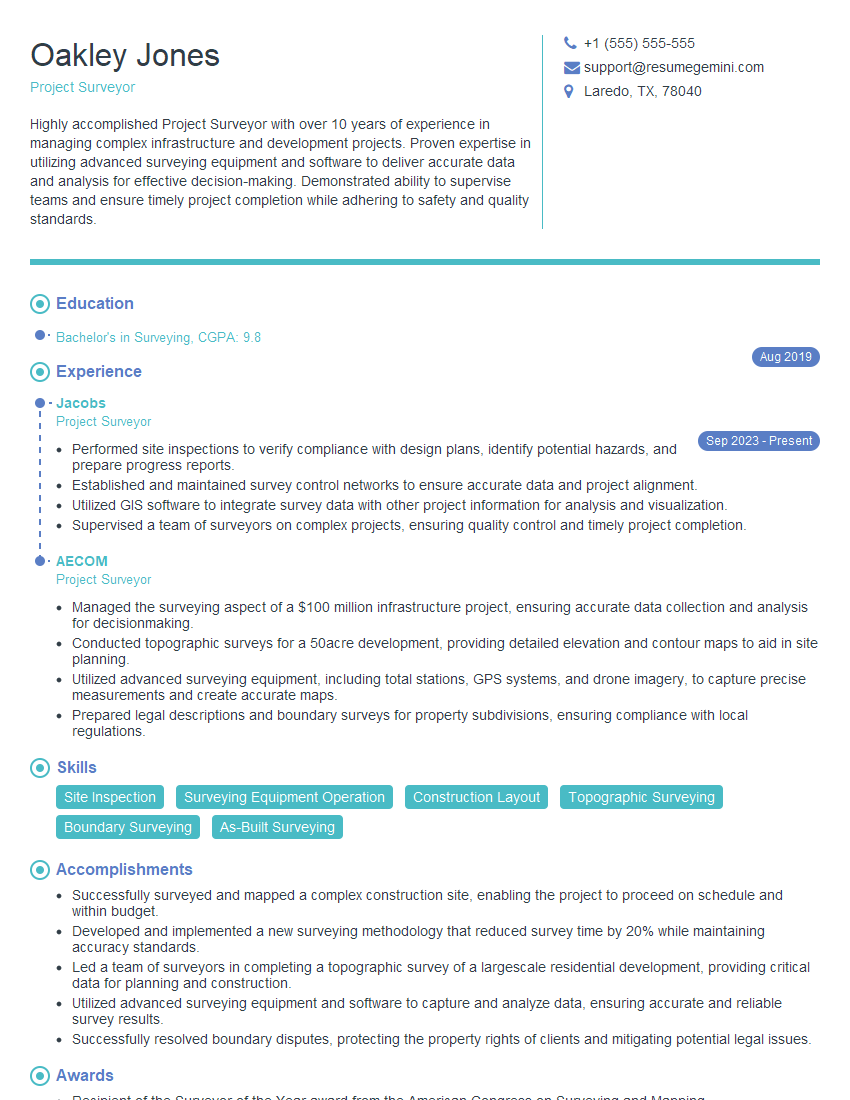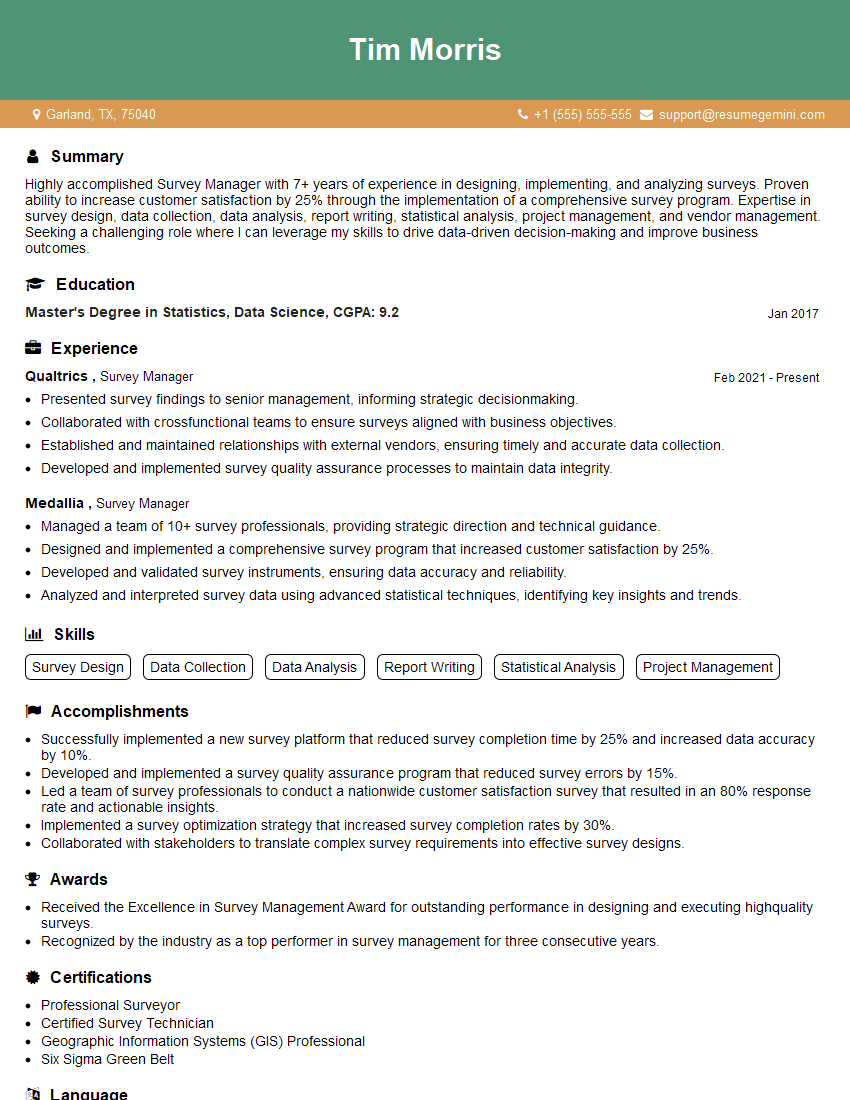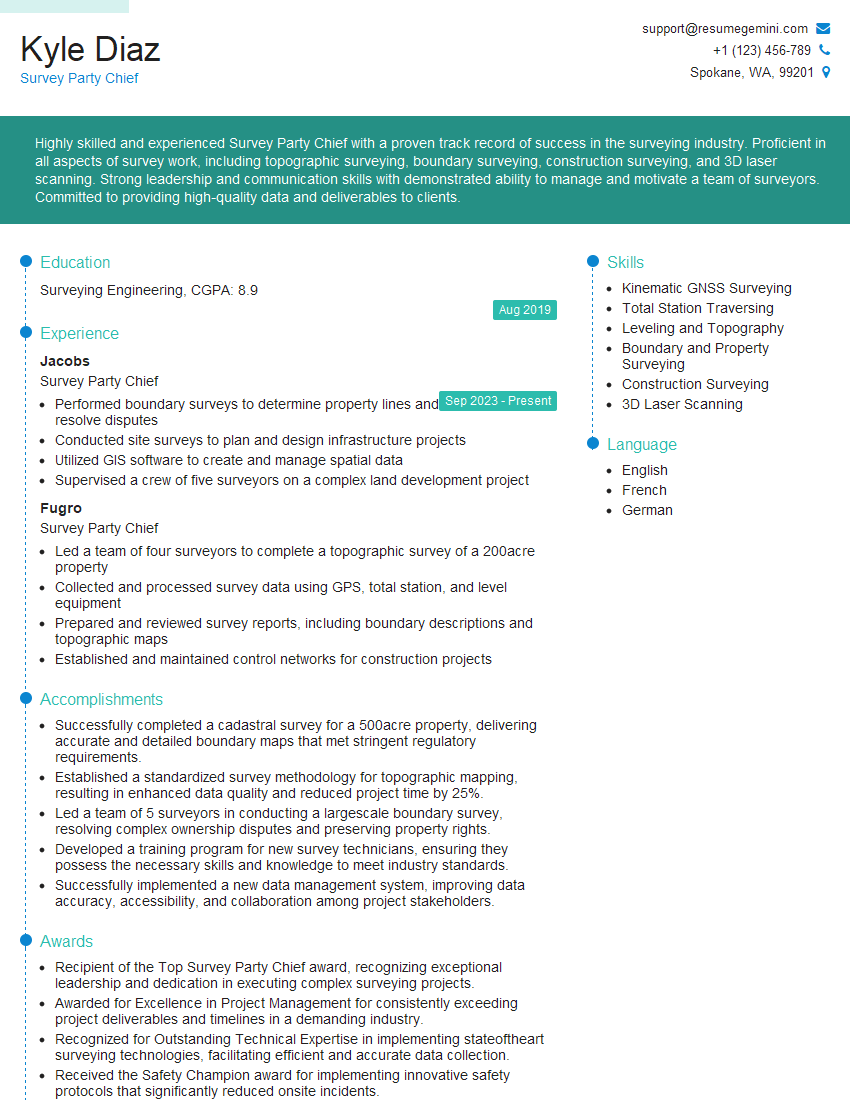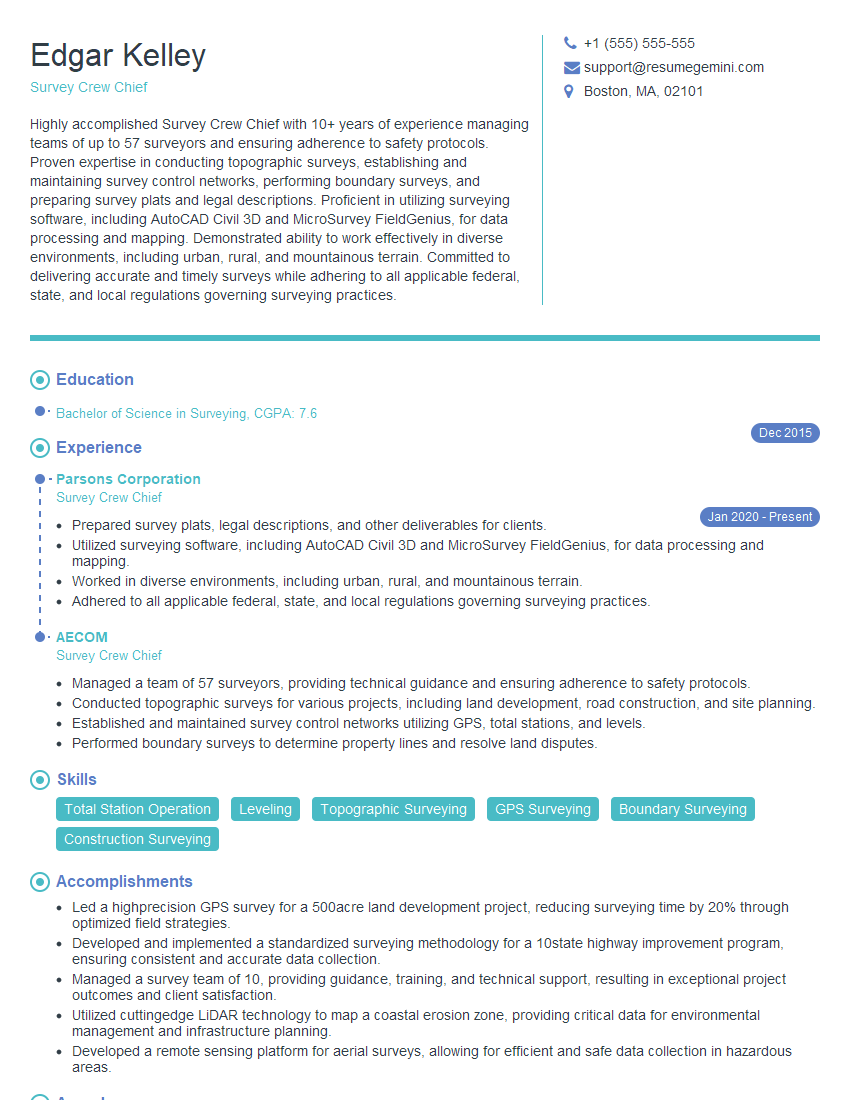The thought of an interview can be nerve-wracking, but the right preparation can make all the difference. Explore this comprehensive guide to Land Surveying Techniques interview questions and gain the confidence you need to showcase your abilities and secure the role.
Questions Asked in Land Surveying Techniques Interview
Q 1. Explain the different types of land surveying.
Land surveying encompasses various specialized techniques, each serving a unique purpose. Broadly, we can categorize them into:
- Plane Surveying: This is the most common type, used for relatively small areas where the Earth’s curvature can be ignored. Think of surveying a residential lot or a small park. We use simple geometric principles and assume a flat surface for calculations.
- Geodetic Surveying: This deals with large areas where the Earth’s curvature must be considered. Mapping entire countries or large infrastructure projects like dams and pipelines falls under this category. It involves more complex calculations and uses advanced coordinate systems like the UTM (Universal Transverse Mercator) system.
- Cadastral Surveying: This focuses on determining and defining property boundaries. It’s crucial for land ownership, legal matters, and property transactions. This often involves historical research to trace boundary lines back through decades, or even centuries, using old deeds and maps.
- Topographic Surveying: This creates detailed maps showing the Earth’s surface features like elevation, contours, and drainage patterns. Think of the contour lines on hiking maps, representing the ups and downs of the terrain. This is used for urban planning, engineering projects, and environmental studies.
- Hydrographic Surveying: This deals with measuring and mapping the physical features of bodies of water like lakes, rivers, and oceans. This involves specialized equipment like sonar and is crucial for navigation, dredging, and marine construction projects.
- Construction Surveying: This is a dynamic field focused on setting out and monitoring construction projects to ensure they are built to the correct dimensions and alignment. This could involve everything from setting out the foundations of a building to monitoring the progress of a highway construction project.
The choice of surveying type depends heavily on the project’s scale, purpose, and complexity.
Q 2. Describe your experience with GPS surveying equipment.
My experience with GPS surveying equipment spans over 10 years, encompassing a wide range of models and applications. I’m proficient in using both Real-Time Kinematic (RTK) and Post-Processed Kinematic (PPK) GPS systems. RTK GPS provides real-time centimeter-level accuracy, ideal for applications requiring immediate positional information, such as stake-out for construction. I have extensive experience utilizing various RTK receivers, including those from Trimble, Leica, and Topcon, mastering data collection, processing, and quality control. PPK, on the other hand, offers high accuracy after post-processing the data, typically used when real-time accuracy isn’t critical. I’ve successfully used PPK techniques for large-scale mapping projects where high accuracy is required after the field work is completed. I am also experienced in using GPS software for data management and analysis, ensuring the accurate processing of large amounts of GPS data.
Q 3. How do you ensure the accuracy of your survey measurements?
Accuracy in surveying is paramount. To ensure it, I employ a multi-pronged approach:
- Calibration and Maintenance: Regular calibration of all equipment, from total stations to GPS receivers, is essential. This involves using certified calibration standards and maintaining detailed records. Equipment is regularly inspected for any issues.
- Redundant Measurements: I always take multiple measurements of each point, using different techniques whenever possible (e.g., measuring a distance both forward and backward). Statistical analysis helps to identify and eliminate outliers. I often repeat measurements on different days to account for the variations in atmospheric conditions.
- Proper Field Procedures: Following strict procedures during data acquisition is crucial. This includes careful instrument setup, proper polarization, and systematic observation methods to minimize systematic errors.
- Quality Control Checks: After data collection, I conduct rigorous quality control checks using statistical analysis and graphical methods. This includes analyzing the distribution of residuals, and performing error propagation analysis to evaluate the precision and accuracy of the results.
- Atmospheric Corrections: For GPS surveying, corrections for atmospheric effects (ionospheric and tropospheric delays) are applied using precise satellite ephemeris data and atmospheric models. These corrections are critical to achieve high accuracy.
By combining these methods, I maintain a high level of confidence in the accuracy of my survey measurements, often achieving centimeter-level precision.
Q 4. What are the common sources of error in land surveying?
Several factors can introduce errors in land surveying. These can be broadly classified as:
- Instrumental Errors: Imperfections in the measuring instruments, such as miscalibration, instrument malfunction, or poor maintenance, can lead to errors. For example, a poorly leveled total station can cause significant errors in elevation measurements.
- Personal Errors: These arise from mistakes made by the surveyor, such as incorrect reading of measurements, improper instrument setup, or errors in data recording and computation. Careful observation and double-checking data can help minimize these errors.
- Natural Errors: These are caused by variations in the environment, such as temperature changes affecting the length of measuring tapes, or atmospheric refraction affecting light signals in EDM measurements. Proper corrections for atmospheric conditions can help mitigate these errors.
- Systematic Errors: These are consistent and repeatable errors that follow a predictable pattern. For example, a constant error in the zero reading of an instrument. These errors can often be detected and corrected through proper calibration and analysis of repeated measurements.
- Random Errors: These are unpredictable and vary randomly. For instance, slight variations in the centering of an instrument. The use of statistical methods can help to minimize the effect of random errors.
Understanding the sources of error and implementing appropriate mitigation strategies is vital for producing accurate and reliable survey results.
Q 5. Explain your understanding of coordinate systems and datums.
Coordinate systems and datums are fundamental to land surveying. A coordinate system is a framework for defining the location of points on the Earth’s surface. Common systems include:
- State Plane Coordinate System (SPCS): Used for smaller regions within a state to minimize distortion.
- Universal Transverse Mercator (UTM): A global coordinate system that divides the Earth into zones, minimizing distortion in each zone. It is often used for large scale mapping projects.
- Geographic Coordinate System (GCS): Uses latitude and longitude to define locations on the Earth’s surface. It’s often used for global positioning and navigation.
A datum, on the other hand, is a reference surface used to define the coordinate system. It’s a mathematical model of the Earth’s shape and size, with different datums offering varying levels of accuracy and suitability for different regions. Common examples include NAD83 (North American Datum of 1983) and WGS84 (World Geodetic System 1984). The choice of datum depends significantly on the project’s location and accuracy requirements. Understanding the relationship between coordinate systems and datums is crucial to ensure that survey data from different sources can be accurately integrated.
Q 6. How do you handle discrepancies in survey data?
Discrepancies in survey data are inevitable, and handling them requires a systematic approach:
- Identify the Discrepancy: First, thoroughly investigate and clearly define the nature and magnitude of the discrepancy. This may involve comparing different sets of survey data, analyzing measurement residuals, and reviewing field notes.
- Investigate the Cause: Determine the likely cause of the discrepancy. Was it due to instrumental errors, personal errors, or environmental factors? Carefully examine potential sources of error in data acquisition and processing.
- Evaluate the Reliability of Data: Assess the reliability of the data involved, considering the methods used, the accuracy of the equipment, and the experience of the surveyor. If one data set is clearly more reliable than another based on these factors, this may guide the resolution.
- Resolve the Discrepancy: Depending on the nature of the discrepancy, resolution may involve re-measurement, adjustment of data using appropriate mathematical models, or averaging of data. Sometimes, it may require a more thorough field investigation.
- Document the Resolution: Meticulously document the steps taken to resolve the discrepancy, including the findings, the methods employed, and any adjustments made. This documentation is essential for transparency and future reference.
In complex cases, consulting with other experienced surveyors or experts may be necessary.
Q 7. Describe your experience with boundary surveys.
I have extensive experience in boundary surveys, a critical aspect of land surveying involving determining and marking property lines. This frequently necessitates historical research involving reviewing old deeds, plats, and maps to trace the evolution of property lines over time. This can often involve interpreting ambiguous descriptions and resolving conflicts that may arise between different historical records. On-site field work is crucial, involving locating existing monuments (markers indicating boundary corners), searching for evidence of past boundaries, and analyzing the physical features of the land. Modern surveying techniques, particularly GPS, are invaluable in determining precise locations and establishing new boundary markers when necessary. I use GIS software to perform boundary analysis, visualizing different data layers (e.g. deeds, aerial photographs, topography) to facilitate boundary determination. The final product of a boundary survey is a precise map showing the property boundaries, often accompanied by a legal description for use in title transfer and other legal processes. Accuracy and precision are paramount in boundary surveys, as any error can have significant legal and financial consequences.
Q 8. What software are you proficient in for data processing and mapping?
My proficiency in land surveying software is extensive. I’m highly skilled in using industry-standard software packages such as AutoCAD Civil 3D, Trimble Business Center, and ArcGIS. AutoCAD Civil 3D is my go-to for creating precise drawings, designing alignments, and performing volume calculations. Trimble Business Center is crucial for processing data from GNSS (Global Navigation Satellite System) equipment, ensuring accurate coordinate systems and error correction. Finally, ArcGIS allows me to create, manage, and analyze geospatial data, enabling the creation of comprehensive maps and spatial analysis.
For example, on a recent project involving a large-scale subdivision, I used AutoCAD Civil 3D to design the road network, calculate cut and fill volumes, and generate the final construction plans. Trimble Business Center was instrumental in processing the raw GPS data collected in the field, ensuring the accuracy of the final design. ArcGIS then facilitated the integration of this data with existing base maps and other relevant spatial information for a comprehensive presentation to the client.
Q 9. Explain your experience with legal descriptions and property lines.
Legal descriptions and property lines are fundamental to my work. I have extensive experience interpreting various legal descriptions, including metes and bounds, lot and block, and government rectangular surveys. Understanding these descriptions is crucial for accurately determining property boundaries. I’m adept at resolving boundary disputes through careful analysis of deed records, field evidence, and relevant regulations. This often involves reviewing historical documents, identifying potential discrepancies, and utilizing survey techniques to establish the true boundary location on the ground.
For instance, I once worked on a case where two neighboring property owners disagreed about their shared boundary. By carefully analyzing the original deeds, conducting a thorough field survey, and considering relevant case law, I was able to establish the correct boundary, resolving the dispute to the satisfaction of both parties. This involved using both traditional surveying techniques and modern GPS technology to ensure accuracy.
Q 10. How do you ensure compliance with safety regulations on survey sites?
Safety is paramount on every survey site. I meticulously adhere to OSHA (Occupational Safety and Health Administration) regulations and all relevant site-specific safety plans. Before any fieldwork, I conduct thorough risk assessments, identifying potential hazards such as traffic, uneven terrain, underground utilities, and weather conditions. This includes utilizing appropriate Personal Protective Equipment (PPE), such as high-visibility clothing, safety glasses, and hard hats.
My team and I follow strict protocols for working near traffic, utilizing flaggers and warning signs. We always mark and avoid underground utilities, using utility locators and contacting relevant utility companies before commencing work. We also employ safe operating procedures for equipment, regularly conducting maintenance and inspections. In inclement weather, we suspend operations to avoid risks. Furthermore, all team members receive regular safety training to ensure everyone is aware of potential hazards and safe working practices.
Q 11. Describe your experience with topographic surveys.
Topographic surveys are a significant part of my expertise. I’ve conducted numerous topographic surveys using a variety of methods, including conventional level and rod techniques, total station instruments, and GPS. These surveys involve determining the three-dimensional position of points on the earth’s surface to create a detailed representation of the terrain. This data is critical for various applications such as planning construction projects, designing infrastructure, and creating detailed maps. The accuracy of these surveys is paramount for ensuring the successful implementation of various projects.
For example, I recently completed a topographic survey for a large-scale residential development. This involved establishing a control network, using a total station to collect detailed elevation data, and processing the data to create contour lines, spot elevations, and a digital terrain model (DTM). This DTM was then used by the engineers to design the grading and drainage plans for the development. The accuracy of this survey was crucial for ensuring the efficient and cost-effective construction of the project.
Q 12. How do you prepare a survey report?
Preparing a comprehensive survey report is the culmination of the surveying process. The report needs to be clear, concise, and easy to understand, even for non-technical audiences. It typically includes a title page, introduction summarizing the project scope, a description of the methodology employed, a detailed presentation of the results (often including maps, diagrams, and tables), and conclusions and recommendations. The report must also clearly outline any limitations or uncertainties associated with the data. Accuracy and precision in all aspects of the report are paramount to ensure client confidence and legal compliance.
For example, a typical report for a boundary survey would include a detailed description of the survey methods used, a plat showing the property boundaries, a table of coordinates for boundary corners, and any relevant legal descriptions. The report will also clearly state any assumptions made, potential sources of error, and any unresolved discrepancies.
Q 13. Explain your experience with construction staking.
Construction staking is a crucial aspect of land surveying that directly impacts construction efficiency and accuracy. My experience encompasses all aspects of this process, from initial planning and design review to field layout and monitoring. It involves setting precise markers on the ground to guide construction activities, such as building foundations, roads, and utilities. This requires a high level of accuracy and attention to detail. Often, it involves working closely with construction crews to ensure accurate placement and resolving any on-site issues.
For example, while working on a highway construction project, I was responsible for staking out the centerline, pavement edges, and utility locations. This involved using a total station and GPS to establish precise points on the ground, following the design plans provided by the engineers. The accuracy of this staking was crucial to ensure that the highway was built to the correct dimensions and alignment, ensuring efficient construction and preventing costly errors.
Q 14. How do you handle challenging terrain during surveying?
Challenging terrain requires adapting surveying techniques and employing specialized equipment. Obstacles like dense vegetation, steep slopes, and water bodies necessitate careful planning and execution. In such situations, I might utilize alternative surveying methods, such as employing drones for aerial data acquisition in areas inaccessible by ground methods, or using robotic total stations which can measure over significant distances. Safety considerations are paramount in challenging terrain, and additional safety measures are implemented to ensure the well-being of the surveying team.
For instance, while surveying a mountainous region for a pipeline project, we utilized a combination of GPS and robotic total stations to overcome the challenges of steep slopes and dense vegetation. The robotic total station allowed us to remotely measure points from a safe location, while GPS provided additional control and accuracy. We also employed rigorous safety protocols, including the use of harnesses and ropes on particularly steep sections.
Q 15. What is your experience with using Total Stations?
Total stations are the workhorses of modern surveying. My experience spans over eight years, encompassing a wide range of applications from boundary surveys and construction layout to topographic mapping and as-built documentation. I’m proficient in operating various models, including Leica, Trimble, and Sokkia instruments. This involves not only setting up and operating the equipment but also understanding its capabilities and limitations – for instance, knowing when atmospheric conditions might affect accuracy and implementing appropriate corrections. I’m comfortable with all aspects, from basic distance and angle measurements to more advanced functionalities like robotic total station operation and data logging. For example, on a recent large-scale construction project, utilizing a robotic total station allowed for significantly faster and more efficient stakeout of foundations, ultimately saving both time and money.
Career Expert Tips:
- Ace those interviews! Prepare effectively by reviewing the Top 50 Most Common Interview Questions on ResumeGemini.
- Navigate your job search with confidence! Explore a wide range of Career Tips on ResumeGemini. Learn about common challenges and recommendations to overcome them.
- Craft the perfect resume! Master the Art of Resume Writing with ResumeGemini’s guide. Showcase your unique qualifications and achievements effectively.
- Don’t miss out on holiday savings! Build your dream resume with ResumeGemini’s ATS optimized templates.
Q 16. Describe your experience with data collection and processing workflows.
My data collection and processing workflow typically begins with careful planning. This involves understanding the project requirements, choosing the appropriate equipment and techniques, and developing a comprehensive field data collection strategy. In the field, I ensure precise instrument setup and meticulous data capture, paying close attention to detail and implementing quality control measures throughout. After field work, the data is processed using software such as AutoCAD Civil 3D, ArcGIS, and specialized surveying software like Carlson or MicroSurvey. This includes data cleaning, coordinate transformations, error analysis, and the generation of deliverables such as contour maps, cross-sections, and digital terrain models (DTMs). For instance, I recently managed a project involving LiDAR data which required specialized software and expertise in point cloud processing to generate high-resolution terrain models and identify features of interest. This involved filtering noise, classifying points, and generating deliverables in a variety of formats.
Q 17. Explain the importance of proper data management in surveying.
Proper data management is paramount in surveying; it’s the foundation of accuracy, reliability, and project success. Think of it as the backbone of any survey project. Poor data management can lead to costly errors, disputes, and legal challenges. My approach involves a structured system, including consistent file naming conventions, detailed metadata, robust backups, and the use of a version control system. This ensures data integrity, traceability, and facilitates efficient collaboration among team members. For example, using a cloud-based storage system allows for secure access to project data from anywhere, facilitating easy collaboration and reducing the risk of data loss. Moreover, metadata, which includes information such as instrument calibration details and environmental conditions, is crucial for ensuring the validity and reliability of the collected data.
Q 18. How do you interpret survey plans and specifications?
Interpreting survey plans and specifications requires a keen eye for detail and a thorough understanding of surveying principles and standards. I begin by carefully reviewing the project documents, identifying key features, boundaries, and specifications. This involves understanding the scale, coordinate systems, symbols, and notations used. I then cross-reference the plan with the field data to identify any discrepancies and ensure the collected data aligns with the project requirements. For example, interpreting a plan that specifies a certain level of accuracy for a boundary survey necessitates understanding how that accuracy translates into field measurements and processing procedures. Any ambiguities in the plan would be clarified with the client or project engineer before proceeding with fieldwork. I always prioritize clarity and communication to avoid any misunderstandings.
Q 19. What is your experience with using LiDAR technology?
My experience with LiDAR technology includes data acquisition, processing, and analysis. I’ve worked on projects utilizing both airborne and terrestrial LiDAR systems. Airborne LiDAR is excellent for large-scale topographic mapping, while terrestrial LiDAR is ideal for capturing high-resolution point clouds of smaller areas, like building facades or infrastructure assets. My expertise lies in processing and analyzing the massive point clouds generated by these systems. This includes filtering noise, classifying ground points, creating digital elevation models (DEMs), and extracting various features like buildings, trees, and power lines. For instance, on a recent highway design project, we used airborne LiDAR to create highly accurate terrain models, which were crucial for planning the road alignment and minimizing environmental impact. This allowed for a better understanding of the existing terrain and efficient planning for the new highway route.
Q 20. Describe your problem-solving skills in relation to surveying challenges.
Problem-solving is inherent to surveying. Challenges arise frequently – ranging from equipment malfunctions to unexpected site conditions. My approach involves a systematic process: first, identifying the problem, then gathering all relevant information, including field notes, data logs, and any other pertinent documents. Next, I analyze the problem, considering all possible causes. This may involve consulting technical manuals, researching relevant literature, or collaborating with colleagues. Finally, I implement a solution and rigorously test its effectiveness. For instance, I once encountered an unexpected underground utility line during a site survey. By utilizing GPS and other available data to verify the location and subsequently communicating this vital information to the client, we avoided a potentially costly incident. This involved adapting my work plan immediately and carefully documenting the discovery and subsequent actions to ensure the safety of the entire project team.
Q 21. Explain your knowledge of different types of surveying errors (systematic, random).
Understanding surveying errors is crucial for ensuring accuracy and reliability. Systematic errors are consistent and repeatable, resulting from a flaw in the equipment or methodology, such as an improperly calibrated instrument or a consistent mistake in field procedures. Random errors are unpredictable and vary from measurement to measurement, caused by factors like variations in atmospheric conditions or human error. Identifying and mitigating these errors is critical. Systematic errors can often be eliminated through proper calibration and adherence to standard operating procedures. Random errors can be reduced through multiple measurements and statistical analysis. For example, systematic error in a total station could be caused by a faulty distance sensor. By regularly calibrating the instrument, this error can be minimized. Random errors might manifest as slight variations in measured angles due to wind conditions, mitigated by multiple readings and averaging.
Q 22. How do you calculate areas and volumes from survey data?
Calculating areas and volumes from survey data is fundamental to land surveying. We typically use several methods, depending on the complexity of the data and the desired accuracy. For simpler polygons, like those formed by boundary surveys, we can use coordinate geometry. This involves using the coordinates of each corner point to calculate the area using formulas such as the trapezoidal rule or Gauss’s area formula.
Coordinate Geometry Example: Imagine a simple four-sided parcel with coordinates (0,0), (100,0), (100,50), (0,50). Using the trapezoidal rule, the area would be approximately [(0+100)/2 + (100+0)/2] * 50 = 5000 square units. For more complex shapes with many points, we’d utilize software that employs algorithms like the shoelace formula for precise calculations. This formula is computationally efficient and robust for handling irregularities.
For volume calculations, we often deal with earthworks or cut-and-fill analysis. This usually involves breaking down the area into smaller cross sections (using techniques like the ‘average end area’ method or the ‘prismoidal formula’), calculating their area, and then integrating the areas to obtain the volume. Software plays a crucial role in speeding up these calculations and handling large datasets. We must always consider the limitations of our chosen method – the accuracy of the area and volume estimations is directly linked to the quality of our field data and the precision of our calculations.
Q 23. Describe your experience with photogrammetry techniques.
Photogrammetry has become an invaluable tool in my practice. I’ve used it extensively for creating highly accurate digital terrain models (DTMs) and orthophotos. These are particularly beneficial in areas with difficult terrain or dense vegetation. Imagine a steep hillside where traditional surveying methods would be time-consuming and potentially dangerous. Photogrammetry, using drone-captured imagery, allows me to safely and efficiently create a detailed 3D model.
My experience encompasses various aspects, from project planning (flight planning, ground control point establishment) to processing the imagery using software like Pix4D or Agisoft Metashape. This involves things like image alignment, point cloud generation, mesh creation and finally texture mapping. Quality control is essential, and this often involves comparing the generated model with ground control points to assess the accuracy. The resulting data is extremely useful for tasks such as site analysis, volume estimations, and creating accurate maps.
Q 24. What is your experience with using GIS software for data analysis and visualization?
GIS software is integral to my workflow. I use ArcGIS and QGIS extensively for data analysis, visualization, and reporting. My experience includes importing and managing survey data (points, lines, polygons), performing spatial analysis (e.g., buffer analysis, overlay analysis), creating maps and visualizations, and generating reports to communicate findings effectively to clients. For example, recently I used GIS to analyze the impact of a proposed road construction project on local wetlands. This involved overlaying the road design on a wetland map to identify areas of potential encroachment and quantify any potential habitat loss.
Furthermore, I am proficient in using GIS to manage large spatial datasets, ensuring data integrity and accuracy. This includes georeferencing scanned maps, integrating data from various sources, and maintaining a well-organized geodatabase. I also utilize GIS to streamline my workflow, automating repetitive tasks and improving the overall efficiency of my work. It’s become indispensable for efficient data management and powerful visual communication of survey data.
Q 25. Explain your knowledge of surveying legal principles and regulations.
Understanding surveying legal principles and regulations is paramount. My knowledge encompasses property boundaries, land titles, easements, and right-of-way issues. I’m familiar with the legal implications of survey errors and the importance of adhering to professional standards. This includes understanding local, state, and national surveying legislation and codes of conduct.
I’ve been involved in several projects where a thorough understanding of legal principles was crucial. For example, resolving a boundary dispute required a meticulous review of historical survey records, deeds, and legal documents to establish the legally defined property lines. Any survey must comply with the relevant regulations to ensure legal defensibility. Misunderstandings can lead to costly and time-consuming legal battles, so compliance and accuracy are not just professional best practices but crucial to protecting both my clients and myself.
Q 26. How would you approach surveying a challenging site with limited access?
Surveying a challenging site with limited access requires careful planning and adaptation of traditional techniques. My approach would start with a thorough reconnaissance of the site to identify access limitations and potential hazards. This would inform the selection of appropriate equipment and methods.
For example, if access is restricted, I might employ robotic total stations, which allow for remote operation and data collection from a safe distance. In extremely tight spaces, I might use 3D laser scanning, capturing a point cloud which can later be processed to create a highly detailed survey model. Alternatively, techniques like drone surveying and photogrammetry, as mentioned before, can be used to acquire data from inaccessible areas without needing physical access. Each approach would necessitate careful consideration of error propagation and the accuracy achievable under the given limitations. The client needs to be fully informed about potential cost and time increases when dealing with such situations.
Q 27. How do you manage a survey team and delegate tasks efficiently?
Managing a survey team effectively involves clear communication, delegation, and fostering a collaborative environment. I believe in assigning tasks based on team members’ individual skills and experience, ensuring everyone feels valued and challenged. Regular briefings are essential to keep everyone informed about project progress, deadlines, and any changes in the plan.
Effective communication includes using precise terminology, clear instructions, and providing all the necessary resources for each task. I also encourage feedback and open communication to address any issues or challenges promptly. Regularly checking the quality control procedures and coordinating field and office work are other essential tasks. Ultimately, a successful survey team relies on effective leadership, well-defined roles, and a shared commitment to accuracy and safety.
Q 28. Explain your experience with different types of survey equipment (levels, theodolites).
My experience with survey equipment is extensive. I’m proficient in using various levels, including automatic levels and digital levels. I understand the principles of leveling, and I know how to perform accurate leveling procedures to establish benchmarks and create level networks. I have a detailed understanding of the different types of levels, including their strengths and limitations.
Similarly, I’m skilled in using theodolites, both optical and electronic. I understand how to perform various measurements such as horizontal and vertical angles, distances, and coordinates. My experience includes using the latest total station technology, which integrates distance measurement, angle measurement, and data recording into a single instrument. Regular calibration and maintenance of the equipment are crucial to ensure accuracy and reliability. Throughout my career, staying updated on the latest technologies has been essential to deliver high-quality, efficient work for our clients.
Key Topics to Learn for Land Surveying Techniques Interview
- Basic Surveying Principles: Understanding fundamental concepts like coordinate systems (UTM, State Plane), surveying measurements (distance, angle, elevation), and sources of error.
- Leveling and Elevation Determination: Practical application of leveling techniques, including differential leveling and trigonometric leveling, to establish accurate elevations for construction and mapping projects. Problem-solving involves understanding and mitigating sources of error in leveling procedures.
- Traversing and Boundary Surveys: Mastering traversing methods for establishing property boundaries and creating accurate land records. Practical application includes understanding different types of traverses (open, closed) and their respective error adjustments. Problem-solving involves dealing with discrepancies in measurements and navigating complex boundary situations.
- GPS and GNSS Techniques: Understanding the principles of Global Navigation Satellite Systems (GNSS) and their applications in surveying, including RTK GPS for high-precision measurements. Practical application includes data processing and error analysis. Problem-solving involves dealing with signal obstructions and multipath errors.
- Topographic Surveying and Mapping: Creating topographic maps from field data using various techniques, including contouring and digital terrain modeling (DTM). Practical applications include site planning, construction design, and environmental studies. Problem-solving involves interpreting topographic data and creating accurate and useful maps.
- Construction Surveying: Applying surveying techniques to support construction projects, including setting out building lines and levels, monitoring progress, and performing volumetric calculations. Practical applications include understanding construction drawings and specifications. Problem-solving involves resolving discrepancies between design and as-built conditions.
- Legal Aspects of Surveying: Understanding the legal framework surrounding land surveying, including property boundaries, easements, and right-of-way. Practical applications include understanding and interpreting legal descriptions and surveying regulations. Problem-solving includes resolving boundary disputes and ensuring compliance with legal requirements.
- Data Processing and Software: Familiarity with common surveying software packages (e.g., AutoCAD Civil 3D, ArcGIS) used for data processing, analysis, and map production. Problem-solving involves using software effectively to analyze data, detect errors, and generate accurate outputs.
Next Steps
Mastering Land Surveying Techniques is crucial for career advancement in this field, opening doors to specialized roles and increased earning potential. Building a strong, ATS-friendly resume is essential for maximizing your job prospects. ResumeGemini is a trusted resource that can help you craft a compelling resume that highlights your skills and experience effectively. Examples of resumes tailored to Land Surveying Techniques are available to help guide you in this process. Invest the time to showcase your expertise – your future self will thank you!
Explore more articles
Users Rating of Our Blogs
Share Your Experience
We value your feedback! Please rate our content and share your thoughts (optional).
What Readers Say About Our Blog
This was kind of a unique content I found around the specialized skills. Very helpful questions and good detailed answers.
Very Helpful blog, thank you Interviewgemini team.


